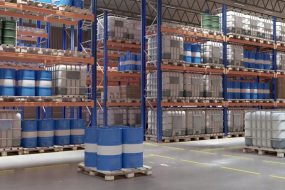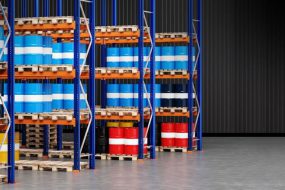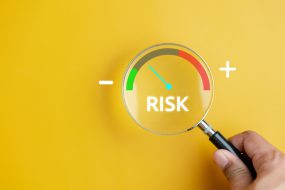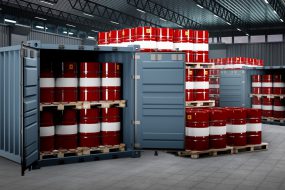Have you ever considered how hazardous materials like flammable liquids, chemicals, or batteries are shipped safely? These dangerous goods require special care since even a tiny mistake can lead to serious problems. Advanced tracking technologies are improving the management of these shipments.
Today, systems can alert us to potential issues before they happen, ensuring safety at every step. This modern logistics approach protects people and communities and helps businesses transport dangerous goods confidently.
The role tracking and technology play in dangerous goods management
It’s essential to monitor dangerous goods and their condition constantly. Real-time tracking helps ensure safety by allowing businesses to identify risks before they cause problems, protecting workers and communities.
Technology has made tracking easier. For instance, AI tracking systems provide constant monitoring and can predict issues before they occur. These tools make logistics faster, smoother, and safer.
The challenges businesses face in dangerous goods tracking
Keeping abreast with the rules
Handling dangerous goods is quite challenging when it concerns the rules governing them. The problem is that they are not the same. Businesses must stay updated and compliant or risk fines, safety, and trust. The good news? More innovative systems can help companies navigate this puzzle while keeping operations running smoothly and safely.
The high stakes of oversights
When businesses deal with hazardous materials, mistakes are costly and can be catastrophic. A missed safety check or a training gap can cause businesses to experience spills, accidents, or worse. Not only are people and the environment at risk, but fines, lawsuits, and reputational damage can leave a lasting impact. The best solution is to take a proactive approach to identifying risks before they become disasters. Think of it as playing defence—businesses can anticipate the moves of potential hazards and stay one step ahead.
Why outdated tracking methods are not viable
Relying on paper logs and manual processes to track dangerous goods today is like using a flip phone in the age of smartphones. They work but are slow, prone to errors, and can’t give real-time updates when tasks go wrong. And when handling hazardous materials, logistics companies can’t afford delays or blind spots. Modern tracking systems, with their real-time updates and better visibility, are the way forward. They ensure you know what is happening, where it is happening, every step of the way.
Technological innovations for tracking and visibility
Internet of Things (IoT)
Imagine tracking shipments in real-time, no matter where they are. With sensors that monitor temperature and humidity, companies can be confident that their cargo is safe and on course. Whether hazardous materials or delicate goods, IoT ensures they are being appropriately handled—no surprises, no manual checks.
RFID and barcode technology
RFID and barcodes make cargo tracking faster and more reliable. These tools help businesses closely monitor shipments, especially when dealing with hazardous materials. With a scan, companies can get precise data, reducing errors and ensuring compliance with safety standards.
Drones and autonomous vehicles
Drones and autonomous vehicles are increasingly used for transporting hazardous materials, especially to remote or challenging locations. These technologies improve shipping efficiency, reduce human exposure to dangerous goods, and provide real-time tracking. They also offer greater visibility and faster emergency response.
Related article: The Impact of 5G Technology in Transforming Logistics and Transportation
Why better tracking means better business
Securing hazardous goods
Safety cannot be an afterthought when shipping dangerous goods. Thanks to the power of IoT sensors, companies can now monitor every shipment in real time, checking temperature shifts and possible leaks. The best part is that potential risks are identified early so businesses can act fast before anything goes wrong. With the proper data, companies can fine-tune their safety plans and stay ahead of problems, ensuring fewer accidents and a safer environment.
Smarter shipping, lower costs
If businesses wish to make their shipping process more efficient and reduce costs simultaneously, they could achieve this via enhanced tracking technologies. Take RFID, for example—this technology automates inventory checks, eliminating time spent manually scanning items and reducing costly mistakes.
Companies can optimise routes and loads by gaining a clearer view of their supply chain, making shipping safer, faster, and more cost-effective. This efficiency keeps logistics operations running smoothly.
Staying compliant with ease
Meeting regulations is challenging but more straightforward with the right tracking tools. Businesses can use blockchain for a secure, unchangeable cargo journey record. This digital trail makes documentation effortless and ensures businesses are always ready for inspections. With a tamper-proof record of hazardous materials, staying compliant with strict standards becomes almost automatic.
Building trust through transparency
Customers want peace of mind while waiting for their shipment, especially when it is a delicate or hazardous load. By offering real-time tracking, companies give their customers the reassurance they need—knowing exactly where their goods are and that they are safe. A solid shipping tracker boosts customer satisfaction and builds long-term trust. When clients know they can rely on a business, they are likelier to remain loyal.
Related article: Exploring the Future of Supply Chain Transparency with Blockchain Technology
How to get started with better tracking systems
Integrating new technology into existing systems
Upgrading tracking capabilities doesn’t require starting from scratch. Advanced technologies such as automated reporting and cloud computing can seamlessly integrate into existing systems.
Automated reporting reduces paperwork errors, while cloud computing allows teams, suppliers, and regulators to access and update shipment information in real-time, creating a more connected, efficient system.
Training the team for success
Even the most advanced technology cannot function effectively without proper training. It is essential to focus on the technical aspects of new systems and the importance of these tools, particularly in hazardous materials management. Technology becomes valuable in ensuring efficiency and safety when the team understands the systems and relevant safety regulations.
Collaborating with the right partners
Successful tracking system implementation requires the right partnerships. Technology providers specialising in hazardous materials management offer crucial guidance during setup and integration. Collaboration with suppliers and regulatory bodies ensures alignment on compliance and operational needs, making the system more effective for all stakeholders.
Monitoring for continuous improvement
Once the new system is in place, it is vital to monitor its performance regularly. Tracking key metrics and gathering feedback from the team will highlight areas for improvement. Continuous assessment helps fine-tune processes and ensures the tracking system evolves to meet changing needs.
Final thoughts
Dangerous goods tracking is becoming essential in logistics. With IoT, AI, and blockchain technologies, businesses can monitor real-time shipments, improving safety and efficiency. These tools also help ensure compliance and prevent issues before they arise.
Looking ahead, the future of logistics is all about transparency and smarter operations. For any business, now is the time to see how tracking technology can improve operations and make shipping safer and more reliable.
As a trusted partner, contact us now to optimise your business needs!




